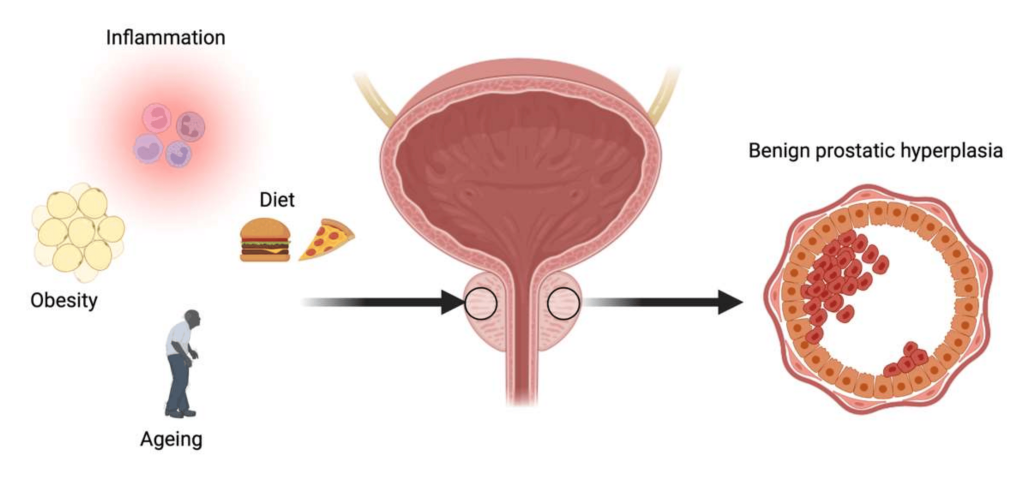Benign prostatic hyperplasia (BPH) and hypercholesterolemia are common conditions that often affect men as they age. BPH is a non-cancerous enlargement of the prostate gland, which can lead to urinary symptoms such as difficulty in starting urination, a weak urine stream, and frequent urination, especially at night. Hypercholesterolemia, characterized by high levels of cholesterol in the blood, is a significant risk factor for cardiovascular diseases.
Emerging research suggests a potential link between these two conditions, indicating that metabolic disturbances, including hypercholesterolemia, may contribute to the development and progression of BPH. Understanding this relationship is crucial for developing integrated approaches to managing these prevalent health issues in aging men.

Is there link between BPH and hypercholesterolemia?
Yes, there is evidence suggesting a link between BPH and hypercholesterolemia. Research indicates that metabolic syndrome and its components, including high cholesterol levels, may play a role in the development and progression of BPH. Some of the key points highlighting this link include:
- Shared Risk Factors: Both BPH and hypercholesterolemia share common risk factors such as aging, obesity, and a sedentary lifestyle.
- Inflammation: Chronic inflammation, which is associated with high cholesterol levels, can contribute to the development of BPH. Inflammatory processes may promote prostate tissue growth and enlargement.
- Hormonal Influence: Cholesterol is a precursor for steroid hormones, including testosterone and dihydrotestosterone (DHT), which are known to influence prostate growth. Dysregulated cholesterol metabolism can affect the hormonal balance and contribute to BPH.
- Vascular Health: Hypercholesterolemia can lead to vascular problems, including reduced blood flow and endothelial dysfunction, which may impact the prostate and contribute to BPH.
- Clinical Studies: Some clinical studies have found associations between elevated cholesterol levels and an increased risk of BPH. These studies suggest that managing cholesterol levels might help reduce the risk or severity of BPH.
Indications of surgery in BPH patients with hypercholesterolemia
The relationship between benign prostatic hyperplasia (BPH) and hypercholesterolemia regarding the need for surgical treatment is not entirely straightforward and may vary among individuals. Here are some considerations:
- Severity of BPH Symptoms: The decision for surgical treatment (such as transurethral resection of the prostate, TURP) in BPH patients is typically based on the severity of symptoms and their impact on quality of life. Hypercholesterolemia itself does not directly dictate the need for surgical intervention unless it contributes to severe urinary symptoms or complicates other health conditions.
- Effect of Hypercholesterolemia: Elevated cholesterol levels and related cardiovascular issues can potentially affect surgical outcomes or influence treatment decisions. For instance, cardiovascular risk factors may need to be managed carefully before surgery to reduce perioperative complications.
- Treatment Approach: In many cases, BPH management starts with lifestyle modifications, medications (such as alpha-blockers or 5-alpha-reductase inhibitors), and minimally invasive procedures before considering surgical options. Hypercholesterolemia management, if present, would be integrated into the overall treatment plan.
- Individualized Care: Each patient’s situation is unique, and the decision for surgical treatment depends on a thorough assessment of symptoms, overall health status, response to conservative treatments, and risk factors like hypercholesterolemia.
In summary, while hypercholesterolemia may influence overall health and treatment decisions, the need for surgical treatment in BPH patients is primarily determined by the severity of urinary symptoms and their impact on daily life. Management of both conditions, when present together, should be integrated to optimize outcomes and reduce risks associated with surgical interventions.
Treatment of BPH in patientds with hypercholesterolemia
The treatment of benign prostatic hyperplasia (BPH) in patients with hypercholesterolemia typically involves a multifaceted approach aimed at managing both conditions effectively. Here are some key considerations and treatment options:
Lifestyle Modifications:
- Dietary Changes: Encourage a heart-healthy diet low in saturated fats and cholesterol. Emphasize fruits, vegetables, whole grains, and lean proteins.
- Exercise: Regular physical activity can help manage weight and improve overall cardiovascular health.
Medications:
- Alpha-Blockers: These medications relax the muscles of the bladder and prostate, improving urine flow and reducing BPH symptoms.
- 5-Alpha-Reductase Inhibitors: These medications reduce the size of the prostate gland by blocking the conversion of testosterone to dihydrotestosterone (DHT).
- Statins: If cholesterol levels are significantly elevated, statin medications may be prescribed to lower cholesterol levels. Statins have also been studied for potential benefits in reducing prostate growth.
Minimally Invasive Procedures:
- Transurethral Microwave Therapy (TUMT) or Transurethral Needle Ablation (TUNA): These procedures use heat energy to reduce prostate tissue and relieve urinary symptoms.
- Prostatic Urethral Lift (UroLift): This involves lifting and holding the enlarged prostate tissue out of the way using implants, which can improve urine flow.
Surgical Options:
- Transurethral Resection of the Prostate (TURP): This surgical procedure removes excess prostate tissue that is obstructing urine flow.
- Holmium Laser Enucleation of the Prostate (HoLEP): Another surgical option that uses a laser to remove prostate tissue.
Integrated Management:
- Coordinate care between urologists and primary care physicians or cardiologists to manage both BPH and hypercholesterolemia concurrently.
- Monitor both conditions regularly to assess treatment efficacy and adjust medications or interventions as needed.
Patient Education and Support:
- Provide education on the importance of adherence to medications and lifestyle modifications.
- Address any concerns or questions the patient may have about treatment options and potential side effects.
In conclusion, treating BPH in patients with hypercholesterolemia involves a tailored approach that addresses both conditions comprehensively. The goal is to improve urinary symptoms while also managing cardiovascular risk factors effectively to optimize overall health outcomes.
Summary
The relationship between benign prostatic hyperplasia (BPH) and hypercholesterolemia suggests a potential link where elevated cholesterol levels may contribute to the development or progression of BPH. Shared risk factors, such as aging and metabolic disturbances, likely play a role. While the exact mechanisms are still under investigation, managing cholesterol levels alongside BPH treatment may be beneficial in mitigating symptoms and reducing disease progression in affected individu
Prof. Dr. Emin ÖZBEK
Urologist
Istanbul- TURKIYE



Leave a Reply